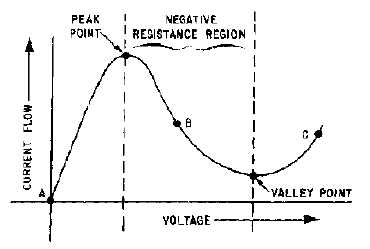2-42
mechanical action called TUNNELING. Tunneling causes the negative-resistance action and is so fast
that no transit-time effects occur even at microwave frequencies. The lack of a transit-time effect permits
the use of tunnel diodes in a wide variety of microwave circuits, such as amplifiers, oscillators, and
switching devices. The detailed theory of tunnel-diode operation and the negative-resistance property
exhibited by the tunnel diode was discussed in NEETS, Module 7, Introduction to Solid-State Devices and
Power Supplies, Chapter 3.
Figure 2-39.—Tunnel-diode characteristic curve.
TUNNEL-DIODE OSCILLATORS.—A tunnel diode, biased at the center point of the negative-
resistance range (point B in figure 2-39) and coupled to a tuned circuit or cavity, produces a very stable
oscillator. The oscillation frequency is the same as the tuned circuit or cavity frequency.
Microwave tunnel-diode oscillators are useful in applications that require microwatts or, at most, a
few milliwatts of power, such as local oscillators for microwave superheterodyne receivers. Tunnel-diode
oscillators can be mechanically or electronically tuned over frequency ranges of about one octave and
have a top-end frequency limit of approximately 10 gigahertz.
Tunnel-diode oscillators that are designed to operate at microwave frequencies generally use some
form of transmission line as a tuned circuit. Suitable tuned circuits can be built from coaxial lines,
transmission lines, and waveguides.
An example of a highly stable tunnel-diode oscillator is shown in figure 2-40. A tunnel-diode is
loosely coupled to a high-Q tunable cavity. Loose coupling is achieved by using a short, antenna feed
probe placed off-center in the cavity. Loose coupling is used to increase the stability of the oscillations
and the output power over a wider bandwidth.

